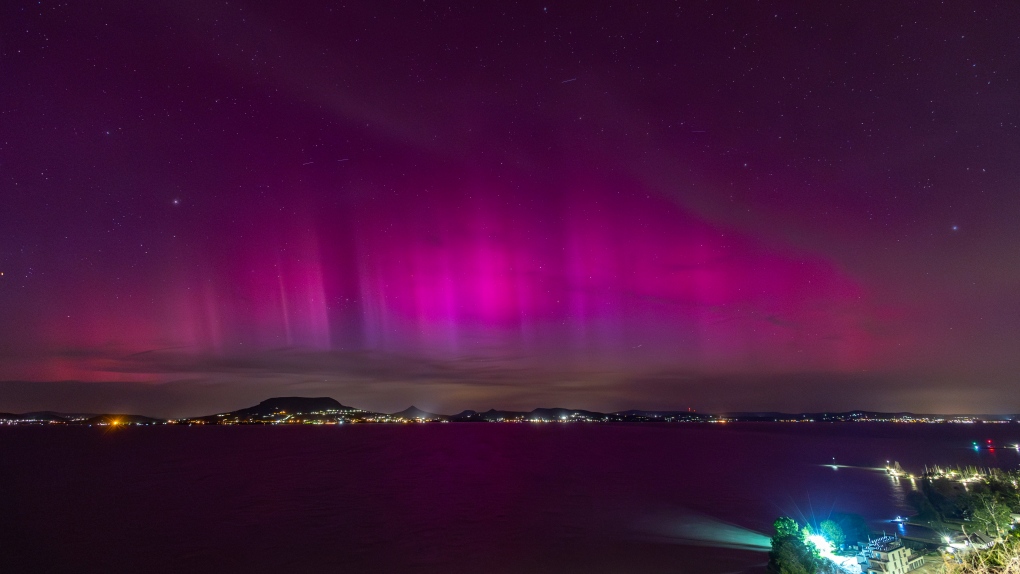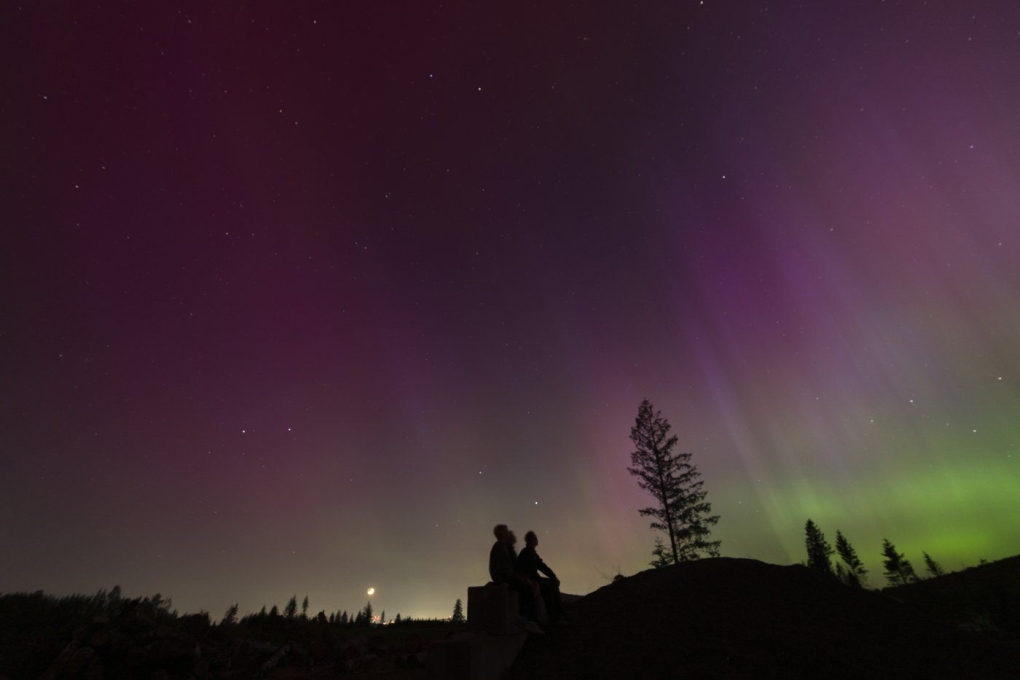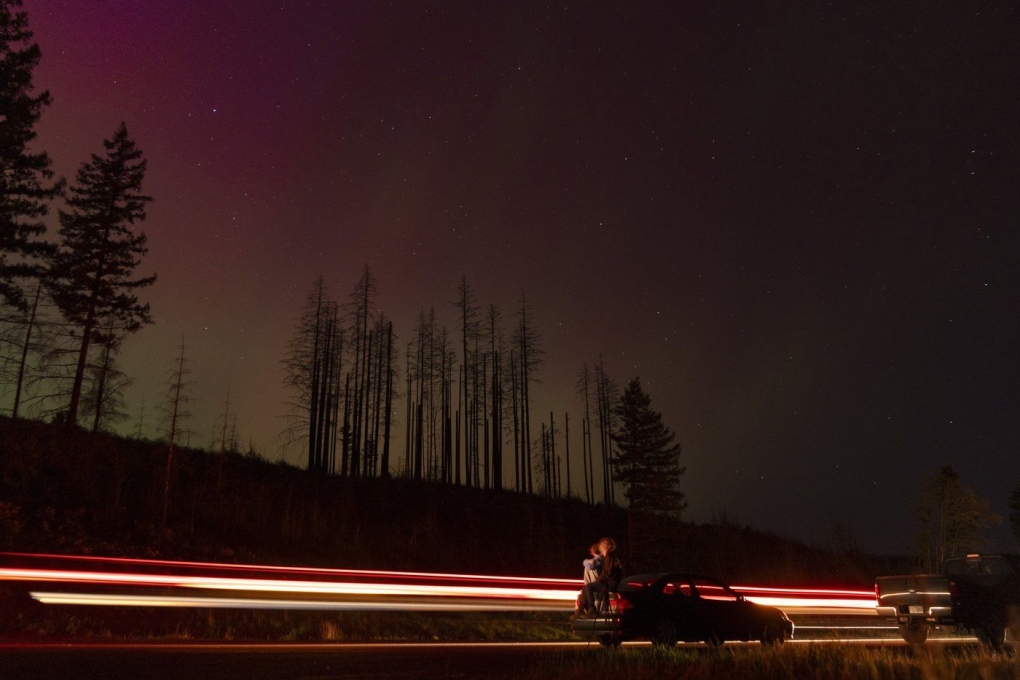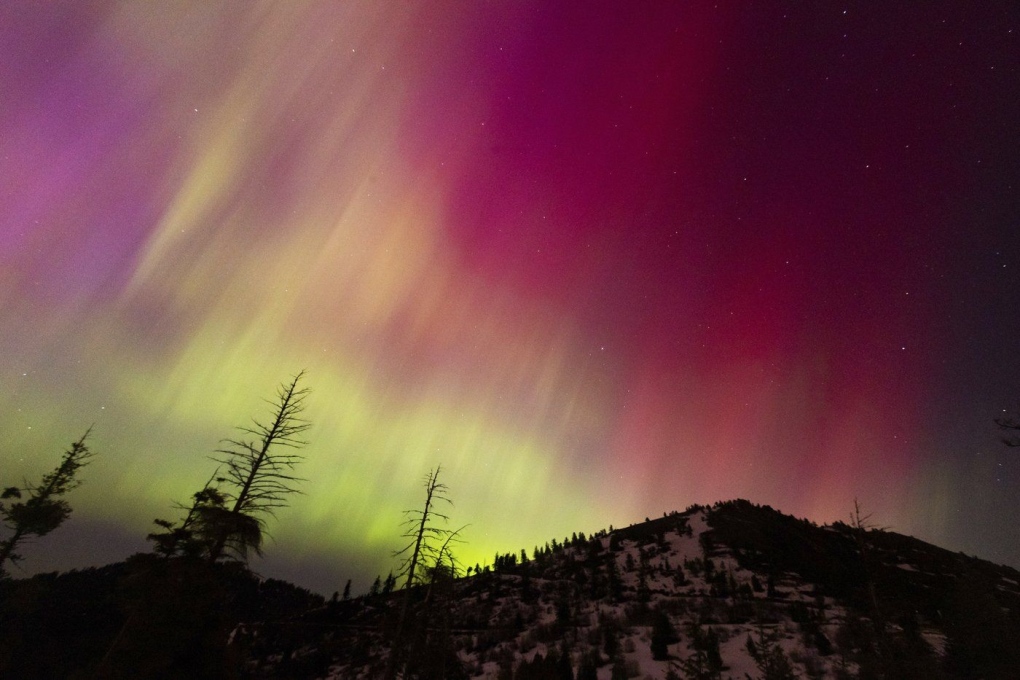
Potential tornado 'surreal' for residents who witnessed damaging storm in southern Ontario
Witnessing a potential tornado was 'surreal' for residents who caught a glimpse of the damaging storm in southern Ontario on Wednesday night.
A powerful solar storm put on an amazing skyward light show around the globe overnight but has caused what appeared to be only minor disruptions to the electric power grid, communications and satellite positioning systems.
The U.S. National Oceanic and Atmospheric Administration said extreme geomagnetic storm conditions continued Saturday, and there were preliminary reports of power grid irregularities, degradation of high-frequency communications and global positioning systems.
But the U.S. Federal Emergency Management Agency said that, so far, no FEMA region had reported any significant impact from the storms. The U.S. Department of Energy said Saturday it is not aware of any impact from the storms on electric customers.
 The Northern Lights, or Aurora Borealis, illuminate the night sky over the Lake Balaton, near Fonyod, Hungary, late Friday, May 10, 2024. (Gyorgy Varga//MTI via AP)
The Northern Lights, or Aurora Borealis, illuminate the night sky over the Lake Balaton, near Fonyod, Hungary, late Friday, May 10, 2024. (Gyorgy Varga//MTI via AP)
NOAA predicted that strong flares will continue through at least Sunday, and a spokeswoman said via email that the agency's Space Weather Prediction Center had prepared well for the storm.
On Saturday morning, SpaceX's Starlink satellite internet service said on its website that service had been degraded and its team was investigating. CEO Elon Musk wrote on the social platform X overnight that its satellites were “under a lot of pressure, but holding up so far.”
Brilliant purple, green, yellow and pink hues of the Northern Lights were reported worldwide, with sightings in Germany, Switzerland, China, England, Spain and elsewhere.
In the U.S., Friday’s solar storm pushed the lights much farther south than normal. The Miami office of the National Weather Service confirmed sightings in the areas of Fort Lauderdale and Fort Myers, Florida. Meteorologist Nick Carr said another forecaster who lives near Fort Lauderdale photographed the lights and was familiar with them because he previously lived in Alaska.
 In this image taken with a long exposure, people look at the night sky towards the northern lights, or Aurora Borealis, on Friday, May 10, 2024, in Estacada, Ore. T (AP Photo/Jenny Kane)
In this image taken with a long exposure, people look at the night sky towards the northern lights, or Aurora Borealis, on Friday, May 10, 2024, in Estacada, Ore. T (AP Photo/Jenny Kane)
People in Kansas, Nebraska, Iowa, Michigan, Minnesota and other Midwestern states were able to capture photos of bright colors along the horizon.
With the solar storm persisting through the weekend, Saturday night offered another chance for many to see the spectacle.
NOAA issued a rare severe geomagnetic storm warning when a solar outburst reached Earth on Friday afternoon, hours sooner than anticipated.
The agency alerted operators of power plants and orbiting spacecraft, as well as FEMA, to take precautions.
“For most people here on planet Earth, they won’t have to do anything,” said Rob Steenburgh, a scientist with NOAA’s Space Weather Prediction Center.
“That’s really the gift from space weather: the aurora,” Steenburgh said. He and his colleagues said the best views may come from phone cameras, which are better at capturing light than the naked eye.
Snap a picture of the sky, and “there might be actually a nice little treat there for you,” said Mike Bettwy, operations chief for the prediction center.
 In this image taken with a long exposure, cars pass by as people look at the night sky towards the northern lights, or Aurora Borealis, on Friday, May 10, 2024, in Estacada, Ore. (AP Photo/Jenny Kane)
In this image taken with a long exposure, cars pass by as people look at the night sky towards the northern lights, or Aurora Borealis, on Friday, May 10, 2024, in Estacada, Ore. (AP Photo/Jenny Kane)
The most intense solar storm in recorded history, in 1859, prompted auroras in central America and possibly even Hawaii.
This storm poses a risk for high-voltage transmission lines for power grids, not the electrical lines ordinarily found in people’s homes, NOAA space weather forecaster Shawn Dahl told reporters. Satellites also could be affected, which in turn could disrupt navigation and communication services here on Earth.
An extreme geomagnetic storm in 2003, for example, took out power in Sweden and damaged power transformers in South Africa.
Even when the storm is over, signals between GPS satellites and ground receivers could be scrambled or lost, according to NOAA. But there are so many navigation satellites that any outages should not last long, Steenburgh noted.
The sun has produced strong solar flares since Wednesday, resulting in at least seven outbursts of plasma. Each eruption, known as a coronal mass ejection, can contain billions of tons of plasma and magnetic field from the sun’s outer atmosphere, or corona.
 The Northern lights fill the sky at the Bogus Basin ski resort on Saturday, May 11, 2024 in Boise, Idaho. (Kyle Green (AP Photo/Kyle Green)
The Northern lights fill the sky at the Bogus Basin ski resort on Saturday, May 11, 2024 in Boise, Idaho. (Kyle Green (AP Photo/Kyle Green)
The flares seem to be associated with a sunspot that is 16 times the diameter of Earth, NOAA said. It is all part of the solar activity ramping up as the sun approaches the peak of its 11-year cycle.
Dunn reported from Cape Canaveral, Fla., Krisher from Detroit and Funk from Omaha, Neb.

Witnessing a potential tornado was 'surreal' for residents who caught a glimpse of the damaging storm in southern Ontario on Wednesday night.
As temperatures rise out of a mild El Nino winter, Canada's buggy season is already upon us again, and this year, the bugs are looking especially big.
WestJet Airlines plans to launch a new cheaper fare category that would be available to travellers willing to fly without a carry-on bag.
Police say they have wrapped up their on-scene investigation into a deadly boat crash in eastern Ontario as details of the incident begin to emerge.
Eating more ultraprocessed foods is linked to a higher risk of cognitive decline and stroke, even if a person is trying to adhere to a Mediterranean diet, the DASH diet or the MIND diet, a new study found.
Cassie Ventura has shared a statement expressing her gratitude for the support she has received since CNN's publication of a 2016 surveillance video that showed her being physically assaulted by her then-boyfriend, Sean 'Diddy' Combs.
Many of the more seriously injured people who were on the Singapore Airlines flight that hit severe turbulence need operations on their spines, a Bangkok hospital said Thursday.
Something shifted in the pretty little village of Lumby, B.C., after Tatjana Stefanski vanished.
Charlie Colin, bassist and founding member of the American pop-rock band Train, best known for their early-aughts hits like 'Drops of Jupiter' and 'Meet Virginia,' has died. He was 58.

When Jujhar Mann said he wanted to be a pastry chef on a grade school career project, he didn't imagine that pursuing his dream would land him on a popular Netflix baking competition.
A city known for its history, ties to outer space and southern barbecue, is also home to a Winnipeg chef dishing out dozens of perogies.
A Montreal photographer captured the moment a Canada goose defended itself from a fox at the Botanical Garden.
Public libraries in Atlantic Canada are now lending a broader range of items.
Flashes of purple darting across the sky mixed with the serenading sound of songs will be noticed more with spring in full force in Manitoba.
Catching 'em all with impressive speed, a 7-year-old boy from Windsor, Ont. who only started his competitive Pokémon journey seven months ago has already levelled up to compete at a world championship level.
A sanctuary dedicated to animals with disabilities is celebrating the third birthday of one of its most popular residents.
2b Theatre recently moved into the old Video Difference building, seeking to transform it into an artistic hub, meeting space, and temporary housing unit for visiting performers in Halifax.
A B.C. woman says her service dog pulled her from a lake moments before she had a seizure, saving her life.